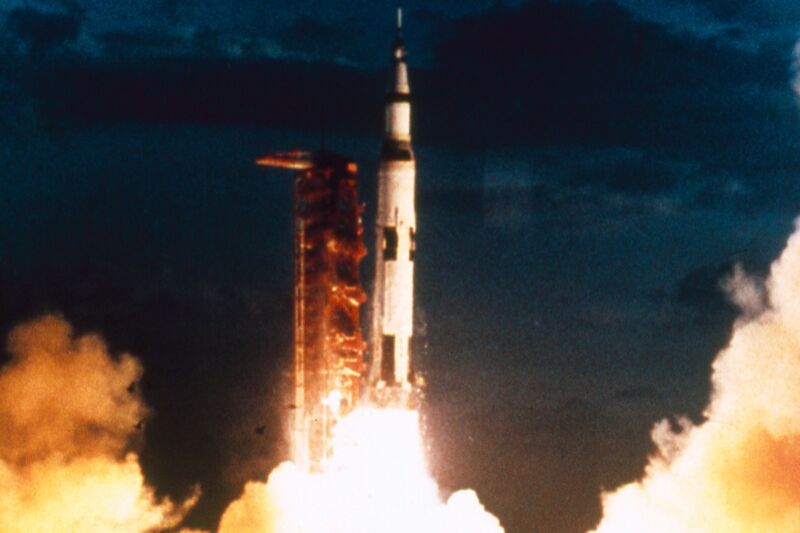
The 1967 Apollo 4 mission was an uncrewed flight to test the Saturn V rocket as a viable launch vehicle for future manned missions. The test was a smashing success and a critical step in the US space program. But the Saturn V was also incredibly loud—so loud that a rumor emerged claiming that the acoustic energy was sufficient to melt concrete. That is not the case, according to an August paper published in a special educational issue if the Journal of the Acoustical Society of America (JASA).
"The Saturn V has taken on this sort of legendary, apocryphal status," said co-author Kenneth Gee of Brigham Young University. "We felt that, as part of the JASA special issue on Education in Acoustics, it was an opportunity to correct misinformation about this vehicle." In addition to the authors' analysis, the paper includes several problems for students to solve relating to the event—including a tongue-in-cheek problem involving using acoustic temperature to make a grilled cheese sandwich.
German rocket scientist Wernher von Braun, who helped build the V-2 rocket, came to work for NASA in 1945 as part of Operation Paperclip. His job was to share his accumulated knowledge with the Army's rocket division. But when the Soviets launched Sputnik 1 in 1957, priorities shifted and von Braun's team was charged with developing an equivalent US rocket. The Juno 1 launched the first US satellite in January 1958, and served as a prototype for the Saturn series for deployment for Earth orbit and lunar missions..
The Apollo 4 mission launched with a Saturn V on November 9, 1967, at 7 AM EST. When the five F-1 engines ignited eight seconds before liftoff, the sound pressure produced was so powerful that the waves buffeted the Vehicle Assembly Building, Launch Control Center, and press buildings even though the launch pad was more than three miles (five kilometers) away. CBS reporter Walter Cronkite and his producer had to hold onto their trailer's observation window as ceiling tiles fell to the floor, fearing it would shatter from the noise. Cronkite later claimed it was the most frightening space mission he'd covered. As one observer of a Saturn V launch described it:
"It's like continuous thunder, and when you think it can't get any louder, it does. I remember the vibration seeming to pass into my bones... The bird rises, the flames spew and the thunder continues, rising in pitch as it climbs, finally dissipating into a sound like a billion sheets of heavy paper being torn lengthwise for a whole minute."
Something that memorable was bound to inspire a few exaggerated claims and unsubstantiated rumors over the ensuing decades. Gee et al. conducted a review of online forums and discussion boards, and were dismayed by the amount of disinformation that had proliferated on them. In addition to claiming the sound level was sufficient to melt concrete, there were claims that it lit "grass ablaze over a mile away," and was powerful enough to "ignite the hair of bystanders" and "blast rainbows from the sky." Per the authors, "Such claims elicit awe at the power of the vehicle that propelled humans to the Moon, but are nevertheless based on a flawed understanding of the true acoustic environment."Apollo 17 was the final lunar landing for NASA's Apollo program. The Saturn V it launched on was SA-512, the twelfth of thirteen Saturn Vs to fly.
Their analysis of that acoustic environment incorporates NASA footage of the Apollo 17 launch—digitized by the Discovery Channel for a 2008 documentary—in which sound waves can actually be seen shortly after engine ignition because of the humid atmosphere and backlighting. Their physics-based model pegged the acoustic level at 203 decibels. Per Gee, 170 dB is equivalent to ten aircraft engines, while 200 dB is equivalent to 10,000 aircraft engines.
Given that the human threshold for pain is around 130 dB, that's pretty darn loud. It just wasn't loud enough to melt concrete or set grass on fire. Gee et al. think the myth evolved out of confusion between sound power (comparable to a light bulb's wattage) and sound pressure (akin to the brightness of a light bulb) This would lead to faulty attempts to calculate the acoustic power of a Saturn V launch. If it turns out that reports of burning grass or melting concrete are confirmed, it would more likely be caused by radiative heating from the plume or debris—not the sound of the Saturn V.
DOI: Journal of the Acoustical Society of America, 2022. 10.1121/10.0013216 (About DOIs).



3175x175(CURRENT).thumb.jpg.b05acc060982b36f5891ba728e6d953c.jpg)


Recommended Comments
There are no comments to display.
Join the conversation
You can post now and register later. If you have an account, sign in now to post with your account.
Note: Your post will require moderator approval before it will be visible.